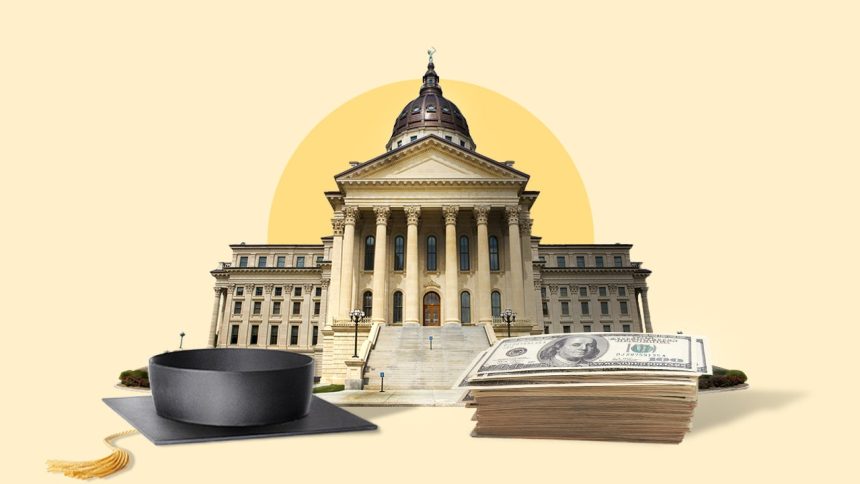Key takeaways
- Some states offer up to thousands of dollars of student loan repayment assistance to new residents.
- Eligibility requirements for these programs vary, so read the fine print carefully before relocating.
- Don’t forget to research student loan forgiveness programs in your own city or state.
- Federal student loans may allow for a federal student loan forgiveness program.
Paying off student loans can be a difficult journey, sometimes taking 20 years or more. While there are federal programs that will forgive your student loans after a certain number of payments, these can be hard to qualify for. Plus, borrowers with private student loans are not eligible for these programs.
Thankfully, there are other ways to find student loan forgiveness, including programs that pay off your loans if you move to a certain state. You can also find state-based repayment assistance programs for current residents through an internet search or your state’s department of education. These programs can help pay off educational debt for certain professionals working in-state.
4 States that want to help pay your student loans
Whether it’s to attract a younger population or stimulate the local economy, states have varying reasons for offering student loan forgiveness to new residents.
Before packing your bags, read the eligibility requirements carefully to see if the program fits you. For instance, many states and cities offer student loan repayment incentives specifically to people working in certain public services, such as in teaching and the health care industry.
Here are examples of states that offer such programs:
1. Kansas
If you move to one of 95 counties in Kansas designated as a Rural Opportunity Zone, you could be eligible for student loan repayment assistance of up to $15,000 over five years. To qualify, you must have a student loan balance in your name and be a new resident of one of these designated areas.
2. Maine
Maine offers student loan payment reimbursement through a program called the Student Loan Repayment Credit. You must be a full-time resident of Maine to be eligible, and there are other eligibility requirements based on the year you graduated. The program is currently undergoing an expansion and simplification overhaul, so some of the details are still being developed.
According to the released information, borrowers who meet the degree, graduation, income and monthly loan payment requirements may be eligible to receive up to $25,000 in lifetime forgiveness.
3. Maryland
Maryland’s SmartBuy 3.0 program provides $6,000 in down payment assistance and student loan repayment assistance to borrowers who want to buy a house. You must have at least $1,000 in student debt to participate. The program will pay off a student loan amount equal to 15 percent of the home cost, with a maximum payoff of $20,000.
At least one borrower’s full student debt must be paid in full by the time of the home purchase. Borrowers must also qualify for the Maryland Mortgage program.
4. Michigan
If you agree to work as a healthcare provider in a Health Professional Shortage Area in Michigan, you may qualify for up to $300,000 in tax-free student loan repayment assistance through the Michigan State Loan Repayment Program. You must participate in the program for at least two years to qualify for the full repayment assistance amount.
What to consider before relocating for loan assistance
Before you move to a new state, be careful to research what the program entails. You should consider:
- If the program matches your career: Many state debt forgiveness programs are meant for certain professionals, like nurses or teachers. Make sure you can get your debt forgiven in your current field.
- General program requirements: Make sure the program fits your lifestyle needs. For instance, the Maryland program is for people looking to buy a house. If homeownership is not a current goal you have, the program won’t be worth it.
- The area’s cost of living: If the area has a much higher cost of living, that might offset any savings from debt forgiveness. For instance, if housing costs you an extra $350,000, but the loan forgiveness equals $25,000, it might not make financial sense to move. On the other hand, if a state does not have income tax, that could make the move more affordable.
4 Additional student loan repayment assistance options
If you aren’t able to relocate and you don’t live somewhere with student loan forgiveness programs that you are eligible for, there are still some options available.
Federal student loan forgiveness
If you have federal student loans, you may be eligible for one of these federal student loan forgiveness programs:
- Public Service Loan Forgiveness (PSLF): The PSLF program requires you to work in a public service job for 10 years, after which you could have your remaining student loan balance forgiven.
- Teacher Loan Forgiveness: Teachers who work for five consecutive years in a low-income school could have up to $5,000 or $17,500 of their student loans forgiven, depending on the subject they teach.
- Perkins Loan Cancellation: If you have a Perkins Loan, you could have up to 100 percent of your loans forgiven by working for five years in an eligible position. This program is available to teachers, nurses, firefighters, librarians and more.
- Income-driven repayment plan (IDR): Several income-driven repayment plans for federal loans base your monthly payment on your income and family size. After 20 or 25 years of payments, your remaining balance will be forgiven.
Major upcoming changes
Due to the One Big Beautiful Bill Act (OBBBA), current IDR plans will no longer be available come July 1, 2026. New borrowers will only have two choices: the standard repayment plan and the Repayment Assistance Plan (RAP), which will be the only income-driven repayment option. Current borrowers on any of the plans will have until July 1, 2028, to switch out. Until RAP officially rolls out, the Department of Education recommends enrolling into the income-based repayment (IBR) program.
- For borrowers on the SAVE plan, interest will resume accruing on Aug. 1.
- PSLF will also no longer be an option for parent PLUS loans.
Employer repayment assistance
By law, your employer may offer up to $5,250 in student loan repayment assistance each year. Currently, this program will continue to be available until Dec. 31, 2025. This amount is tax-free for both borrowers and employers. Ask your HR department if your company offers this benefit.
Major companies such as Google, Hulu and Fidelity Investments offer student loan repayment assistance. As student debt continues to be a mounting problem for young professionals, more and more companies will likely offer repayment assistance as a benefit.
Occupation-based student loan forgiveness
Certain professions like nurses, doctors, lawyers and teachers can access specific student loan forgiveness programs. For example, nurses who work in underserved communities could also have up to 85 percent of their balance forgiven through the Nurse Corps Loan Repayment program.
Try searching online for special forgiveness programs for your profession, especially if you’re a teacher, nurse, doctor or lawyer.
Private student loan repayment
If you don’t qualify for federal forgiveness programs, there are still ways to make your student loan repayment more manageable.
If you have private student loans, refinancing is one of the best ways to do this. This gives you a new interest rate, a new repayment timeline and a new monthly payment.
If you qualify for a lower interest rate, you could save a significant amount over the life of your loan. You might also consider asking for deferment or forbearance of your student loans, temporarily pausing payments.
Keep in mind:
Under the OBBBA, economic hardship and unemployment will no longer be valid reasons for deferment for federal loans. Forbearance terms have also gone down from 12 to nine months.
Student loan refinance calculator
Want to crunch the numbers to see if refinancing is right for you? Bankrate’s student loan refinance calculator is here to help you.
Learn more
Bottom line
State programs can help you forgive some or all of your student loan debt. You can even relocate to take advantage of some programs. Whatever you decide to do, it’s important to review the program details, as these can include areas you must live in, the profession you must work in or other requirements like even buying a home in the area.
If you have federal student loans, you have other forgiveness options, like income-driven repayment plans. Additional student loan forgiveness options include employer repayment assistance or occupation-based student loan forgiveness. You can also make private student loans more manageable through refinancing. Check out current student loan refinance rates to see if you could save.
Why we ask for feedback
Your feedback helps us improve our content and services. It takes less than a minute to
complete.
Your responses are anonymous and will only be used for improving our website.
Help us improve our content
Read the full article here














